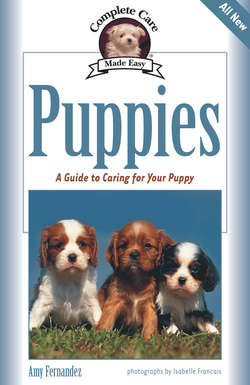Читать книгу Puppies - Amy Fernandez - Страница 34
На сайте Литреса книга снята с продажи.
Coats and Colors—the Icing on the Cake
ОглавлениеIt can be tempting to pick a puppy solely on his appealing coat or color. Personal preference is certainly an important consideration. But this is not the same as shopping for hats or wallpaper. Dog coats come in many varieties—from the short, curly coats of poodles to the long, silky coats of Irish setters. Some dogs have no coat—as is the case with the hairless Chinese crested. The short coat of the Chihuahua makes this pint-size dog better suited for indoor living, whereas the thick, dense coat of the Samoyed protects against harsh, wintry winds in cold climates. Of course, double-coated dogs can be kept comfortable in hot climates with air-conditioning, and shorthaired or hairless breeds can be bundled in sweaters or kept indoors in chilly locales.
Grooming is another issue. Consider the type of terrain in which you live: choosing a longhaired Afghan hound may create a nightmare for you if you live in a rural region, where debris from fields or wooded areas will continually become trapped in your dog’s coat; similarly, it will be near to impossible to keep a dog’s white coat looking pristine if you live in an area prone to rain and mud. Your forethought shouldn’t stop with the main body coat. Some breeds have combination coat types that introduce grooming needs you may not have anticipated. For instance, the hairless Chinese crested does have long, silky hair on the head, tail, and feet; and the schnauzer comes with furnishings (longer hair around the legs and muzzle) that must be kept free from debris and are somewhat susceptible to staining, though the body coat can be kept shorn to a low-maintenance style.
The beautiful heavy coats of Samoyeds such as this one are perfect for winter in the Siberian tundra, where the breed originated. Summer in places such as the American South is more challenging for double-coated dogs.
A golden retriever pup enjoys a swim in the lake. The oils that make a retriever’s coat water-repellent can transfer themselves to your carpet and any furniture he’s allowed on.
Some coats, such as those of retrievers, are naturally water-repellent and are insulated to resist heat and cold. Much of this weather resistance is due to natural coat oils, which also cause a distinct doggy odor that is transferred from the dog to his bed and to your carpet and furniture. Bathing will diminish the odor, but it also strips the protective coat oils, so it shouldn’t be done too frequently.
Maintaining the appearance of a Lakeland terrier’s wirehaired coat may require the attention of a professional groomer. The advantage of having wirehaired dogs is that they shed less than other dogs do.
Short coats, such as those of boxers and Chihuahuas, are generally less complicated to groom, but they offer less protection against hot or cold weather. Single coats—a one-layered coat without an undercoat, such as that of the Italian greyhound—can be fine and thin, offering less protection from the cold and the sun (sunburn can be a risk). Some flat coats, such as those of the German shepherd and the Labrador, have both an outer coat and an undercoat. These double coats offer more insulation from the weather, but they shed more than long coats do. Frequent brushing and vacuuming is essential.
Wiry coats, such as those of terrier breeds, provide protection from rough terrain and extreme weather. Matting and shedding are less of a problem, but the grooming required to maintain their appearance and texture can be complicated. Unless you are prepared to learn how to do this, it can mean regular professional grooming. Clipping will permanently soften the texture, which will greatly diminish the coat’s natural protective qualities.
Long coats are glamorous, but they also require the most grooming. If neglected for even a short time, they will mat. Many longhaired dogs, such as the Samoyed, possess double coats. Dead hair will simply collect in the undercoat, creating mats and secondary skin irritations from the dirt and moisture that become trapped next to the skin. Professional groomers charge hefty fees for special services such as dematting. Worst case scenario, the mats may need to be shaved off, which can permanently alter the hair’s natural texture.
A standard poodle shares the warmth of its thick curly coat with a hairless sphynx cat. Some authorities claim that poodles are less likely to trigger an allergic reaction than other dogs may, but there’s no guarantee this will be the case.
Hypoallergenic Coats
HYPOALLERGENIC AND NONSHEDDING CAN BE misleading terms. Every dog—even hairless breeds—will shed to some extent. No breed can be guaranteed not to provoke an allergic reaction. Firsthand research is indispensable if you plan to acquire a puppy because of his purported hypoallergenic quality. Spending time with a dog is the only way to be sure about this. Don’t base your decision on a quick trip to the breeder; he or she usually will have several dogs (possibly of different breeds) and even other pets on the premises, which may stimulate your allergic reaction and make it difficult for you to evaluate your potential reaction to allergens from just one dog. Instead, visit the home of a friend who owns only the breed you want; stay long enough (which varies from person to person) to possibly trigger an allergic reaction.
Curly coats, often considered nonallergenic and non-shedding, can actually require substantial grooming and are not guaranteed to prevent allergic reactions. They must be brushed every other day to remove dead hair and prevent mats and need to be trimmed every six weeks to three months in order to maintain a tidy appearance.
Whether your puppy has a wire-haired coat, like this fox terrier’s, or a smooth coat, a long coat, or a short one—or not much coat at all—you need to keep her well groomed.
